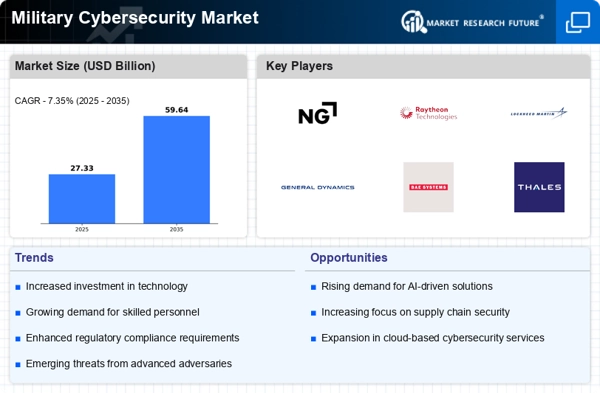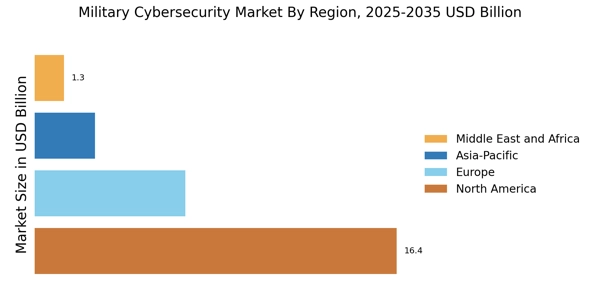Increased Cyber Threats
The Military Cybersecurity Market is experiencing heightened demand due to the escalating frequency and sophistication of cyber threats. Nation-states and non-state actors are increasingly targeting military networks, leading to a surge in investments in cybersecurity solutions. Reports indicate that military organizations are projected to allocate approximately 20% of their IT budgets to cybersecurity measures by 2026. This trend underscores the critical need for advanced cybersecurity technologies to protect sensitive information and maintain operational integrity. As adversaries develop more complex attack vectors, the Military Cybersecurity Market must evolve to counter these threats effectively, ensuring that military assets remain secure and resilient against cyber incursions.
Regulatory Compliance and Standards
The Military Cybersecurity Market is significantly influenced by the need for compliance with stringent regulatory frameworks and standards. Governments are implementing rigorous cybersecurity policies to safeguard national security interests, which compels military organizations to adopt robust cybersecurity measures. For instance, compliance with the Department of Defense's Cybersecurity Maturity Model Certification (CMMC) is becoming mandatory for defense contractors. This regulatory landscape is expected to drive the Military Cybersecurity Market, as organizations invest in technologies and processes to meet compliance requirements. The potential market growth is estimated to reach USD 30 billion by 2027, reflecting the urgency for military entities to align with evolving cybersecurity regulations.
Emergence of Cyber Warfare Strategies
The Military Cybersecurity Market is being shaped by the emergence of cyber warfare strategies, which are becoming integral to national defense policies. As military operations increasingly rely on digital infrastructure, the need for comprehensive cybersecurity measures has never been more critical. Countries are developing offensive and defensive cyber capabilities, leading to a projected market growth of 25% in the next five years. This strategic shift necessitates the integration of advanced cybersecurity solutions to protect military assets and ensure operational readiness. The Military Cybersecurity Market is thus positioned to expand as nations prioritize the development of robust cyber warfare strategies to safeguard their interests in an interconnected world.
Advancements in Cyber Defense Technologies
The Military Cybersecurity Market is witnessing rapid advancements in cyber defense technologies, which are crucial for enhancing military capabilities. Innovations such as machine learning, artificial intelligence, and blockchain are being integrated into cybersecurity frameworks to improve threat detection and response times. The adoption of these technologies is projected to increase the efficiency of military cybersecurity operations, potentially reducing incident response times by up to 50%. As military organizations seek to modernize their cybersecurity infrastructure, the demand for cutting-edge solutions is likely to propel the Military Cybersecurity Market forward, fostering a more secure operational environment.
Growing Investment in Cybersecurity Training
The Military Cybersecurity Market is increasingly focusing on personnel training as a critical component of cybersecurity strategy. As cyber threats evolve, military organizations recognize the importance of equipping their personnel with the necessary skills to combat these challenges. Investment in training programs is expected to rise, with estimates suggesting that military training budgets could increase by 15% over the next five years. This emphasis on training not only enhances the capabilities of military personnel but also strengthens the overall cybersecurity posture of military organizations. Consequently, the Military Cybersecurity Market is likely to benefit from this trend, as organizations seek to develop a skilled workforce adept at navigating the complexities of modern cyber threats.


















Leave a Comment